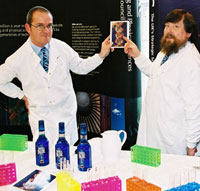A cocktail of nucleic acids: celebrating the double helix Inspire article
Dean Madden and John Schollar from the National Centre for Biotechnology Education at the University of Reading, UK, suggest a recipe for a cocktail containing deoxyribose nucleic acid (DNA.) This drink has novel features of considerable biological interest.

and John Schollar
By combining elements from Cambridge, London and the Americas, this red, white and blue drink pays tribute to all of those who worked on the double helix. A hint of pineapple juice helps to celebrate what Francis Crick called ‘The Golden Helix’.
Equipment & materials
From England:
- 8 frozen strawberries (about 68 g) – the variety ‘Cambridge Favourite’ is naturally the most appropriate.
- London dry gin – the strongest you can find. This is necessary to precipitate the DNA.
N.B. Chill this gin in the freezer for at least 2 hours before preparing the drink.
From the Americas:
- 60 ml fresh pineapple juice. This must be fresh as protease activity is required to degrade the histones associated with the DNA.
- Blue curaçao1.
- Lime juice and icing sugar, to decorate.

Also required:
- A blender2
- Large test tubes or boiling tubes, for serving.
Method
Moisten the rim of a large test tube with lime juice then dip the rim into icing sugar.
Add about 10 ml3 of blue curaçao to the tube.
Tilt the tube then with great care, pour about 20 ml3 of ice-cold gin down the side of the tube to form a layer above the blue curaçao.
Blend the strawberries and pineapple juice for 10 seconds, then drop the purée on top of the gin. Wisps of strawberry DNA will precipitate into the gin.
Discussion
Others have suggested (unpublished data) that thin helical twirls of lime peel may be used to decorate the rim of the tube. More enterprising drinkers have tried to recover the nucleic acid from the gin, using a swizzle stick. We are not aware of the details of the results of these investigations.
Most of the ‘DNA’ in the gin is probably pectin, although the method described here is strikingly similar to the ‘Marmur preparation’ used by molecular biologists throughout the world to prepare DNA4.
It has not escaped our notice that this cocktail contains significant amounts of alcohol and should, therefore, be consumed only by adults and in moderation.
We are much indebted to Peter Finegold for suggesting that we create a cocktail to celebrate the 50th anniversary of the double helix in 2003.
- If it proves difficult to form distinct layers of liquids, dissolve a little sugar in the curaçao.
- A Waring blender, as used by Fred Hershey and Martha Chase, who in 1952 proved conclusively that DNA was the genetic material, seems an appropriate model. Hershey AD, Chase M (1952) Journal of General Physiology 36: 39-56
- Adjust these volumes for smaller tubes.
- Marmur J (1961) Journal of Molecular Biology 3: 208-218





